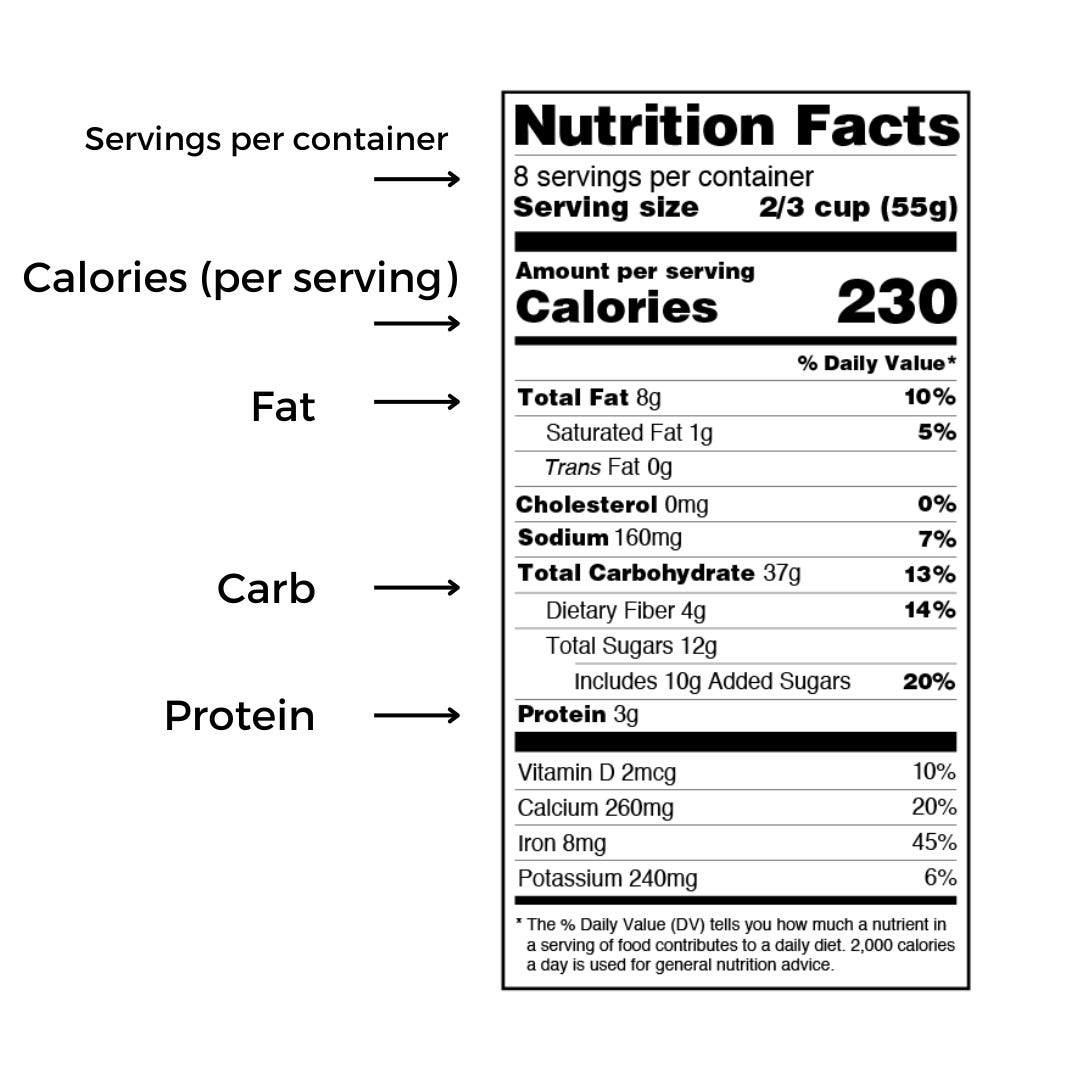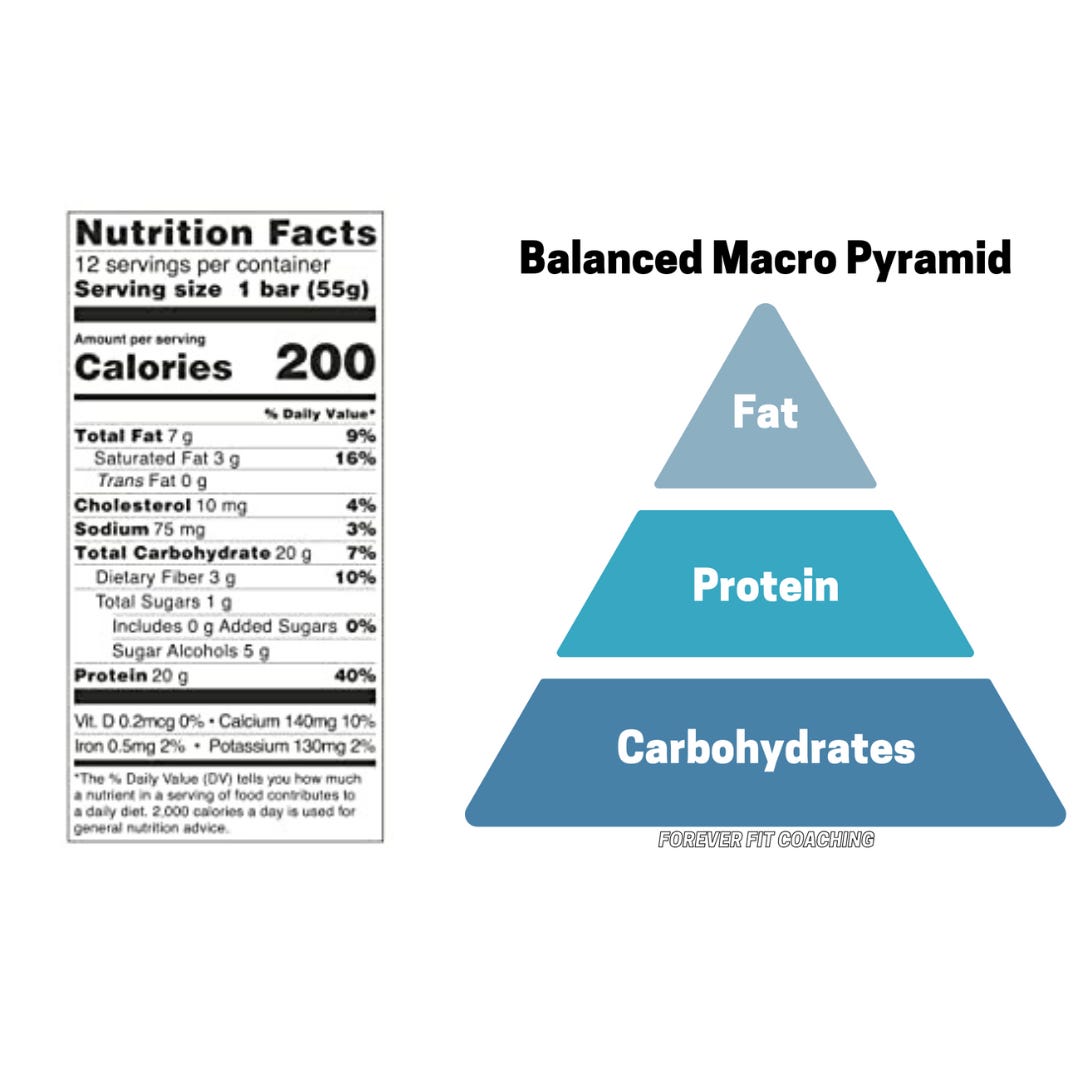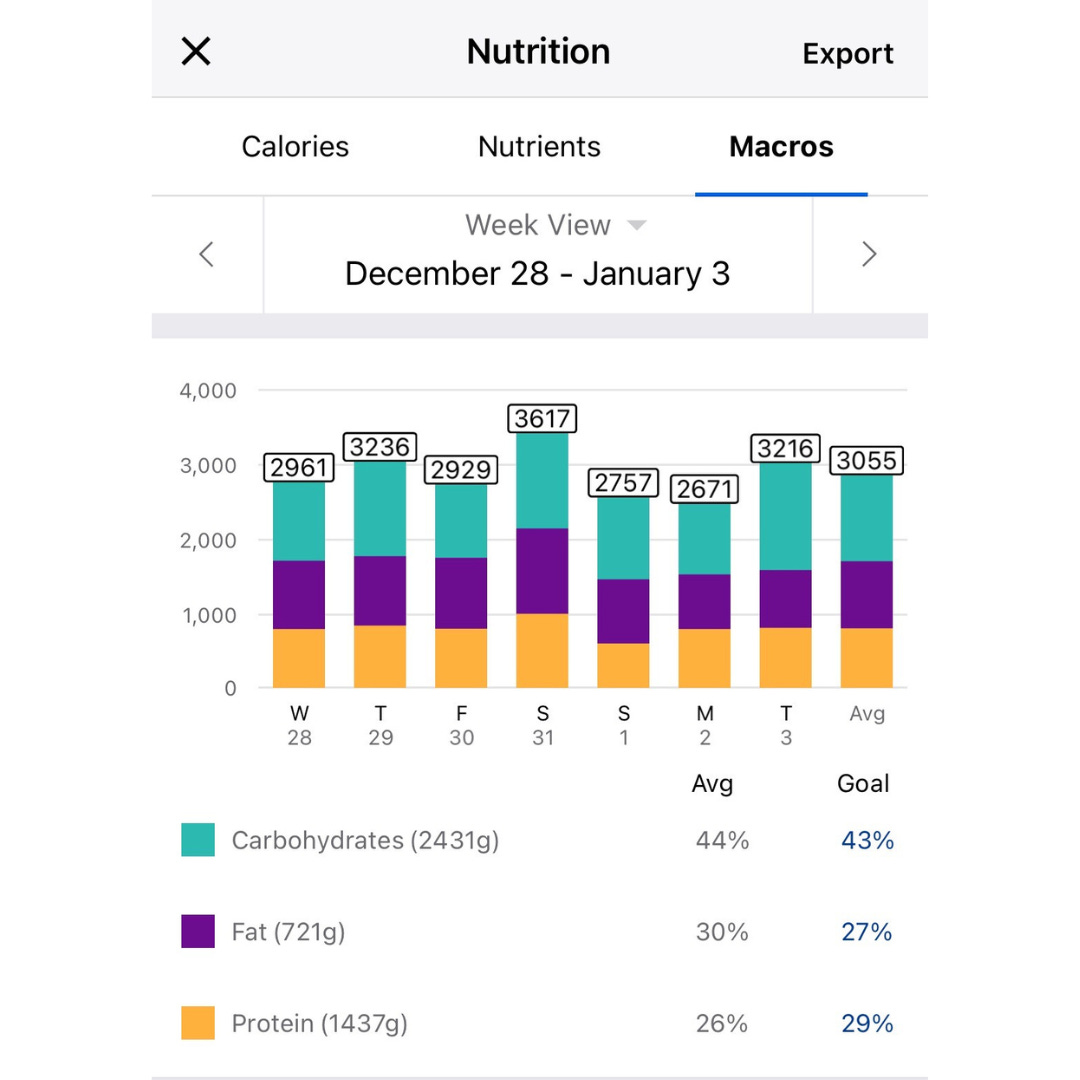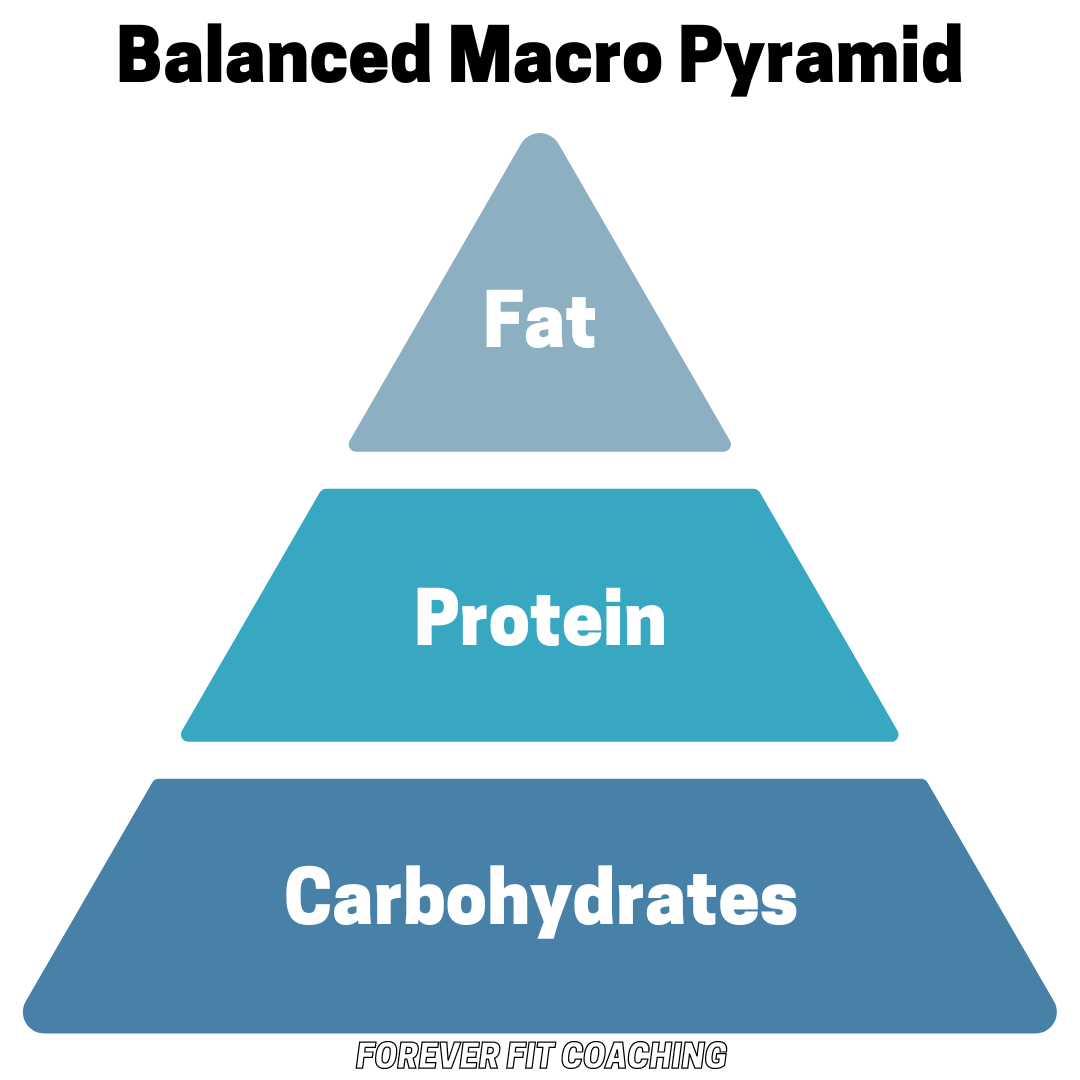How to Use the Balanced Macro Pyramid & Read Nutrition Labels
A tool for the job! Plus more on how using macros is the simplest way to master your nutrition.
This article will explain what balanced macros look like and further describe what to look for when choosing foods to incorporate into your life (or assessing the foods currently in your life). With a basic grasp of macros you can look at a nutrition label and quickly identify the hard facts about the food item. With that you can make an informed decision about the food and whether or not you want to fuel yourself with it.
Before the Macro Pyramid, let’s briefly touch on Nutrition Labels.

The first thing you should know about nutrition labels is they have a margin for error of 20%. Meaning if it says 400 calories it could potentially be 500 calories or 300, a significant difference. This simply highlights the nature of tracking calories being no precise art. It gets us close, though. Close enough to accurately fuel ourselves according to our needs or goals.
When reading a nutrition label your eyes only need to go to a few main places. Let’s highlight those.
Total Calories. It’s the biggest number for a reason: it matters. This number is how many calories are in one serving of the food. There may be more than one serving in the package though!
Servings per Container. If it’s 1 serving per container, the nutrition label is for the whole package. If it’s not, you’ve got to divide those calories per serving by the number of servings to know what you’re actually dealing with calorically.
Before we get to #3 let’s introduce the Balanced Macro Pyramid.
Carbohydrates and Protein have the same amount of calories per gram. Rather than having equal grams from both, a balanced macro approach generally gets a few more grams of carbs and a few less grams of protein simply because carbohydrates are easier to find and consume. Protein is not as common amongst everyday food as carbs, or it takes being cooked or refrigerated to consume. Meanwhile carbs are sitting in the pantry. Lastly, due to the calorie dense nature of fats, macro balance says consume the fewest grams from this energy source. Less grams, but still nearly 1/3 of daily calories come from fats because they are necessary for optimal health.
In this way a nutrition label with balanced macros may mirror the size of the pieces of the pyramid. Most grams carbs. Moderate grams Protein. Least grams Fat.
Back to the Nutrition Label and #3!

Protein. Skip to the bottom of the list, just above the black bar to find the protein content. I have a rule of thumb for myself and for my clients that is how we hit our daily protein goals with relative ease: 15 grams of protein at any snack, at least 30 grams of protein at main meals. If you’re smaller in size or a female you shoot for 12-15 grams with snacks and 20-25 grams at meals. Protein matters. Obviously not every ingredient on your grocery list will have ample protein, but to know the food you should know the value of these macros.
Carbohydrates. Take your eyes up to the carbs, a few lines above protein. Recall the pyramid. Your carbs are generally going to be the largest in grams of the bunch for most foods that contain carbs. For a balanced food you would want roughly 2-3 as many carbs as protein, assuming there is enough protein in it. It’s natural for most foods or meals to have more grams of carbs than grams of protein or fats, that’s generally speaking. (The problem with carbs can come from consuming too many carbs and not enough protein.)
Fats. Lastly, check the fats back near the top. Mind your fats, you don’t have to avoid them, but if you don’t mind them they can quickly add up. At 9 calories per gram they pack twice the punch of carbs and protein and they do little to nothing for satiety or feeling full. That means they go down easy! Have eggs for breakfast. Have avocado toast for breakfast. but if you have eggs and avocado toast for breakfast just know that the majority of the calories you just had were from fats.

Looking at the above label, you can see the protein content rivals the carbohydrates, with modest fats below 10 grams. Granted, this is a protein bar so it is designed this way but it still gives us something to aim for: High protein and low to moderate fat. If you can consistently achieve that, carbohydrates will naturally fall into moderation.
So you’re standing in the grocery store looking at a nutrition label (doesn’t sound sexy, but it’s a place we have all been) and want to determine if the macros are balanced or if the food is wack. When in doubt, picture the pyramid.
Carbs at the bottom and take up the most room, so a balanced nutrition label may have more carbs than anything and still be balanced. Remember, we care most about the protein.
Next, protein is present in significant amounts. Recall the rule of thumb of 10-15 grams of protein for a snack. Any sitting or meal with less than 10 grams of protein could really be improved by adding protein, alone it isn’t doing much.
Fats are small-er and reasonable. Some foods will have no fat, and others will be mostly fat. Eggs, cheese, dairy, higher fat beef, nuts, dips, and oils are all mainly fat sources. Use them in moderation!
Carbs are okay.
Protein is high.
Fats are low to moderate.
If it meets that criteria, try it!
Remember that calorie counting and macro tracking are not exact methods. For this reason it can be helpful to give yourself a range when you using numbers for macros or for your daily calories. Instead of 1,800 calories a day maybe shoot for 1,650 - 1,900 calories and allow for some wiggle room. Same for macros: just setting a protein range goal is SO useful for increasing protein intake. Maybe it’s 100-120 grams a day, or 185-205 grams a day.
Precision helps, but it isn’t required. Consistency is enough for positive effect.
It’s not complicated so don’t act like you can’t do it. Nutrition becomes complicated and overwhelming when you listen to the fear mongers and death dealers on social media talk about this ingredient is poison or that ingredient will make you fat.
That’s too in the weeds.
Maybe you just need some balance and regularity. As a coach I have found that to be very helpful to many people in making them feel better and helping them with weight loss.
No, go with what we know works and research has proven: How much food.
How many calories.
Aim to understand calories.
Then adjust your calorie intake to fit your needs or goals.
Congratulations. You are holding the key to weight management.
A final note on tracking calories or macros…

If you want to improve your health or body composition the daily numbers matter infinitely less than the overall numbers. Consistency is determined by looking at the big picture, not each day individually. Don’t beat yourself up over an off day, or missing the mark. In the above photo of my food diary, I didn’t hit my goal of 3,000 calories a single day of the week. But my daily average for the week was 3,055 calories.
Questions? Let me know, I’m happy to clarify any points or expand on others. I’m not a physician and I’m not a dietician. I am a nutrition coach with years of practical experience with hundreds of happy and successful clients who found sustainable improvements to their lifestyle working with Forever Fit Coaching. If you, or someone you know needs help with improving their health, body composition, or diet send them our way. Share this with them, and let them know there are people out there who care to help them!


